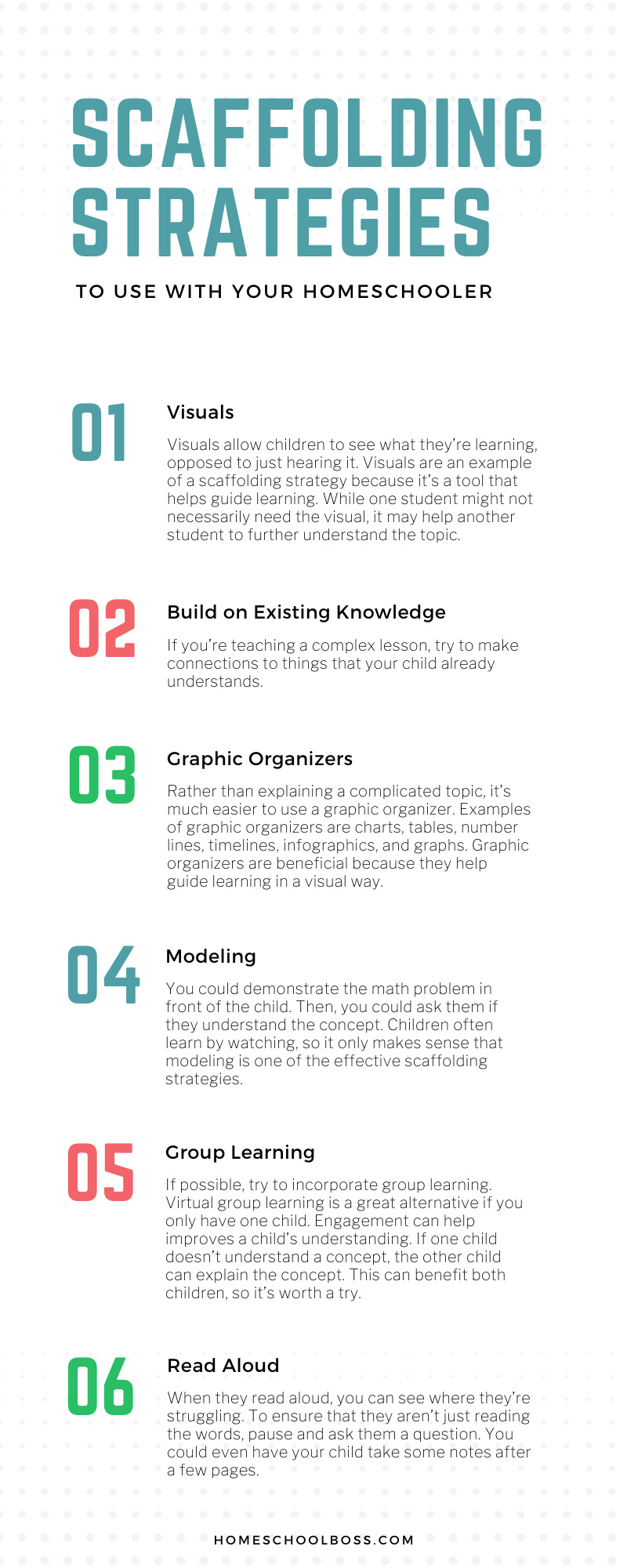
Students do better in school when they feel supported, and homeschooling is no different. There are many ways you can support your child in their learning. One way is via instructional scaffolding. This is a method that breaks up learning into smaller pieces so that students have a better understanding. With scaffolding, there is also some kind of tool or structure that helps guide that learning. Teachers use these strategies daily, so it’s important that you understand them. We put together a guide that explains the scaffolding strategies to use with your homeschooler, so read on to learn more.
Visuals
There are many scaffolding strategies to use with your homeschooler. All children learn differently; so while merely explaining a lesson works for one child, it might not make sense for another. That’s why visuals are so helpful in a learning setting. Visuals allow children to see what they’re learning, opposed to just hearing it. Visuals are an example of a scaffolding strategy because it’s a tool that helps guide learning. While one student might not necessarily need the visual, it may help another student to further understand the topic. Visuals also help children remember things, so there’s more than one benefit.
If you’re wondering how you can use visuals during lessons, consider searching the topic you’re teaching. There are so many helpful resources online, and many of them are free. You could show your child a picture related to the lesson. You could also show an instructional video. For math, you could use blocks to demonstrate counting. For science, you could show a nature documentary. The options are endless when it comes to visuals, so try to get creative with it.
Build on Existing Knowledge
Another scaffolding strategy that helps students understand new concepts is building on existing knowledge. If you’re teaching a complex lesson, try to make connections to things that your child already understands. For example, talking about ecosystems might be confusing for a child. If you start by talking about an ecosystem that they’re familiar with, and then build off that, they’re more likely to understand the new information. If you’re teaching your child about solids, liquids, and gases, they might not understand the different phases. Instead, you can talk about how the snow at your house melts. This is a great example of building off their existing knowledge. Kids understand complex material better this way because it’s not completely new information to them. This allows the child to get comfortable with the topic before moving ahead with new content.
Graphic Organizers
Graphic organizers are something most people can remember learning. That’s because it’s incredibly helpful for learning new information. This is also great for visual learners. Rather than explaining a complicated topic, it’s much easier to use a graphic organizer. This makes the information less overwhelming and easier to absorb. Examples of graphic organizers are charts, tables, number lines, timelines, infographics, and graphs. You can use a graphic organizer during math lessons, for example. Math is a subject that overwhelms most children—and even some parents—so graphic organizers make that information easier to digest. Although math is what comes to mind first, graphic organizers are great for almost every subject. For example, you could use a timeline in a history lesson to explain a specific event. You could use a table to keep track of characters in a novel. You could also use graphic organizers in science to keep data organized during an experiment. Graphic organizers are beneficial because they help guide learning in a visual way.
Modeling
Another way to guide your child through their learning is by modeling the lesson or concept. This is helpful for many students because it allows them to watch how it’s done before they try it themselves. For example, this strategy might be helpful during a math lesson. You could demonstrate the math problem in front of the child. Then, you could ask them if they understand the concept. If they don’t, you can show them another example. This will help them feel confident when they try the math problem on their own. Modeling is helpful because the student can literally see your reasoning. While you do this, make sure you’re explaining each step. This helps the child understand how you got to the conclusion. Children often learn by watching, so it only makes sense that modeling is one of the effective scaffolding strategies.
Group Learning
Group learning is also a great opportunity for students to support each other. This gives children the time to talk to each other and discuss ideas. If one child is struggling with a concept, they can learn from another child. If you have multiple children, an older sibling could help a younger sibling. This can also help alleviate the anxiety of working through something alone. Additionally, it can help build momentum throughout the lesson. Learning alone has its benefits, but it also has its downsides. If possible, try to incorporate group learning. Virtual group learning is a great alternative if you only have one child. Engagement can help improves a child’s understanding. If one child doesn’t understand a concept, the other child can explain the concept. This can benefit both children, so it’s worth a try.
Read Aloud
Reading aloud is another way to ensure your child is understanding the material. When they read aloud, you can see where they’re struggling. To ensure that they aren’t just reading the words, pause and ask them a question. You could even have your child take some notes after a few pages. You must make note of the concept or theme while reading. Ask your child to explain why they think will happen. This is a good way to gauge how well your child understands what they’re learning. Reading aloud provides numerous benefits, so consider implementing it into your routine.
At Homeschool Boss, we aim to make homeschooling as stress-free as possible. We offer online homeschool testing so that you can maximize your child’s learning. Feel free to give us a call if you have any questions. We’re more than happy to help!

Pingback: Important Homeschool Tips for Beginners
Comments are closed.